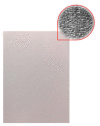FEM Analysis Validation of Rubber Hardness Impact on Mechanical and Softness Properties of Embossed Industrial Base Tissue Papers
- PMID: 35746060
- PMCID: PMC9230954
- DOI: 10.3390/polym14122485
FEM Analysis Validation of Rubber Hardness Impact on Mechanical and Softness Properties of Embossed Industrial Base Tissue Papers
Abstract
The embossing operation is one of the processes of tissue paper converting. The embossing parameters influence the final properties of tissue products, such as mechanical, softness, and bulk. In this study, the influence of the rubber hardness used against the embossing steel rolls with a pattern created by intaglio engraving was studied. Three different configurations of rubber plates stacking, each plate with different hardness, were studied. After embossing, mechanical properties, softness, and bulk were evaluated to analyze the effect of rubbers hardness on these properties. Furthermore, a Finite Element Model of the embossing operation was used that considered the same rubber plates stacking configurations used in experiments, and it was able to replicate the experimental results. This work led us to conclude that the configuration where two rubber plates with different hardness, where the rubber plate with higher hardness is in contact with the tissue paper sheet, has shown to be the best solution to obtain higher softness. These findings support the use of embossing operations rubber rolls with a low hardness internal layer and a high hardness external layer in industry. Thus, finite element models were also shown to be reliable tools to virtually test other configurations, such as, for example, three or more rubber plates with different hardness. Since embossing is one of the tissue paper transformation operations with the greatest impact on the key properties of the final product, this study allows the producer to optimize them by varying the hardness of the rubber roll, as well as its configuration.
Keywords: FEM simulation; embossing prototype; mechanical properties; optical visual inspection; rubber hardness; softness characterization; tissue paper.
Conflict of interest statement
The authors declare no conflict of interest.
Figures






























References
-
- Hilbig K., Liplijn M., Reinheimer H. Method of Making a Thick and Smooth Embossed Tissue. [(accessed on 21 October 2020)]. Available online: https://www.freepatentsonline.com/20050230069.pdf.
-
- Lofink B. Device for Applying an Embossing to a Web of Tissue Paper. [(accessed on 21 October 2020)]. Available online: https://patents.justia.com/patent/20030010228.
-
- Biagiotti M. Tissue Embossing Developments|The Tissue Story. 2017. [(accessed on 8 January 2019)]. Available online: https://www.tissuestory.com/2017/11/21/tissue-embossing-developments/
-
- Skapa Roll Covers for the Paper Industry-World of Roll Covers. 2020. [(accessed on 21 October 2020)]. Available online: http://vit-group.com/skapa/test/download/Produktprospekt_GB.pdf.
-
- Hannecard Embossing Roll (Tissue) [(accessed on 21 October 2020)]. Available online: https://www.hannecard.com/en/industries/tissue/paper-tissue-converting/e...
Grants and funding
- Project InPaCTus - Innovative Products and Technologies from Eucalyptus, Project Nº 21874/Portugal 2020 through European Regional Development Fund (ERDF) in the frame of COMPETE 2020 nº 246/AXIS II/2017
- UIDB/00195/2020/Fundação para a Ciência e a Tecnologia, IP/MCTES through national funds (PIDDAC)
- UIDB/00151/2020/Fundação para a Ciência e a Tecnologia, IP/MCTES through national funds (PIDDAC)
LinkOut - more resources
Full Text Sources

